Are you looking for a small musical instrument with you on your travels? Or perhaps you want something that won’t take up too much space in your home? Whatever your reasons, there are plenty of great small instruments out there to choose from.
This article will introduce you to 15 of the best small musical instruments around. We will tell you a little about each one and what makes it special. So, whether you’re looking for a new instrument to learn or want something different to play, you’re sure to find something perfect for you here.
So, without further ado, let’s take a look at 15 of the best small musical instruments around:
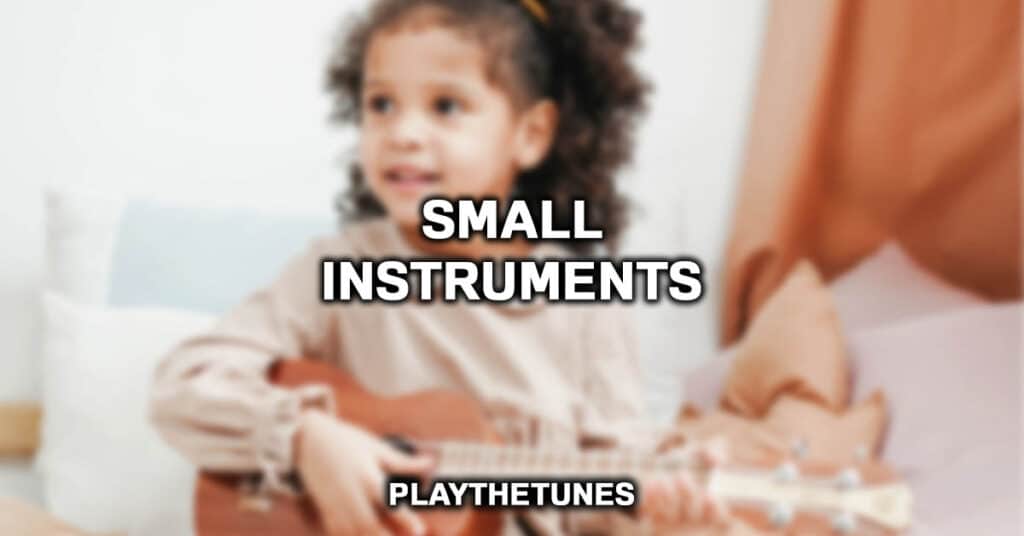
1. Ukulele

The ukulele is a small stringed instrument that originates from Hawaii. It’s similar in appearance to a guitar, but it has only four strings instead of six. It’s a very popular instrument due to its portability and ease of use and it’s perfect for those who are just starting out on their musical journey. In fact, it’s considered one of the easiest musical instruments to learn.
Ukulele is a four-stringed musical instrument of the lute family, typically played by strumming or plucking with the fingers. The term “ukulele” is often used to refer to the four-stringed instruments of the lute family, which include the ukulele, banjo ukulele, and guitarlele.
Expert Tip: Ukuleles come in a variety of sizes and styles, with the most common being the soprano ukulele, also known as the “standard” ukulele. Other popular sizes include the concert ukulele, tenor ukulele, and baritone ukulele.
Ukuleles are commonly used as beginner instruments due to their small size and relative ease of playing. However, ukuleles can be enjoyed by players of all skill levels. Many professional musicians have taken up the ukulele in recent years, and the instrument is now featured in a wide range of genres, including pop, rock, jazz, and even classical music.
If you’re interested in learning to play the ukulele, there are a few things you’ll need to get started. In addition to an instrument, you’ll need a tuner, some form of instruction (like a book or online tutorial), and some practice. With a little time and patience, you’ll be playing your favorite songs on the ukulele in no time!
2. Harmonica
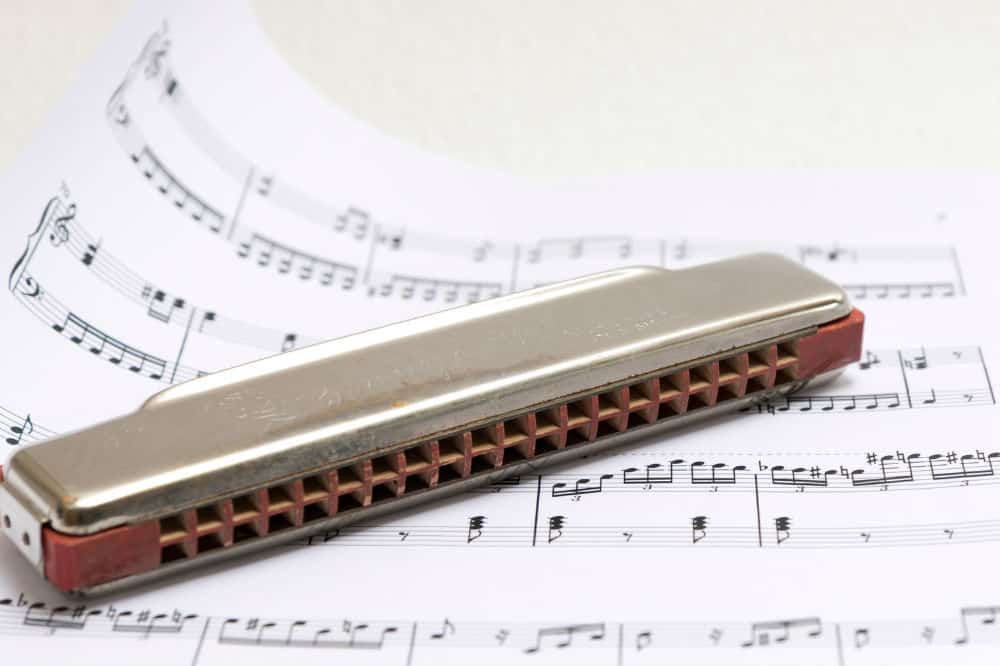
The harmonica is a small wind instrument that consists of a row of metal plates mounted on a central cylinder. It’s held in the player’s mouth and played by blowing air through the holes in the plates. The harmonica is a very versatile instrument that can be used for a variety of genres, from blues and jazz to country and folk.
The harmonica is a small, portable musical instrument that is played by blowing air into it through the reeds. It is easy to carry around and can be played anywhere. The harmonica is a popular instrument among buskers and street performers.
Harmonica comes in different sizes, from the tiny pocket size to the large floor model. The most common type of harmonica is diatonic, which has ten holes and 20 reeds. Each hole plays a different note, and by pressing down on the reeds, the player can create chords.
Chromatic harmonicas have 12 or more holes, and each hole gives access to all the notes in an octave. These are used more often by professional musicians.
Harmonicas are usually made of metal or wood, and the reeds are made of brass or steel. The earliest harmonicas were developed in the early 19th century, and they quickly became popular worldwide. Harmonicas are now used in a wide variety of genres, from country to rock, jazz to classical.
Whether you’re a beginner or a seasoned pro, the harmonica is a great instrument for anyone to learn. It’s easy to get started and with a little practice, you’ll be making beautiful music in no time.
3. Recorder
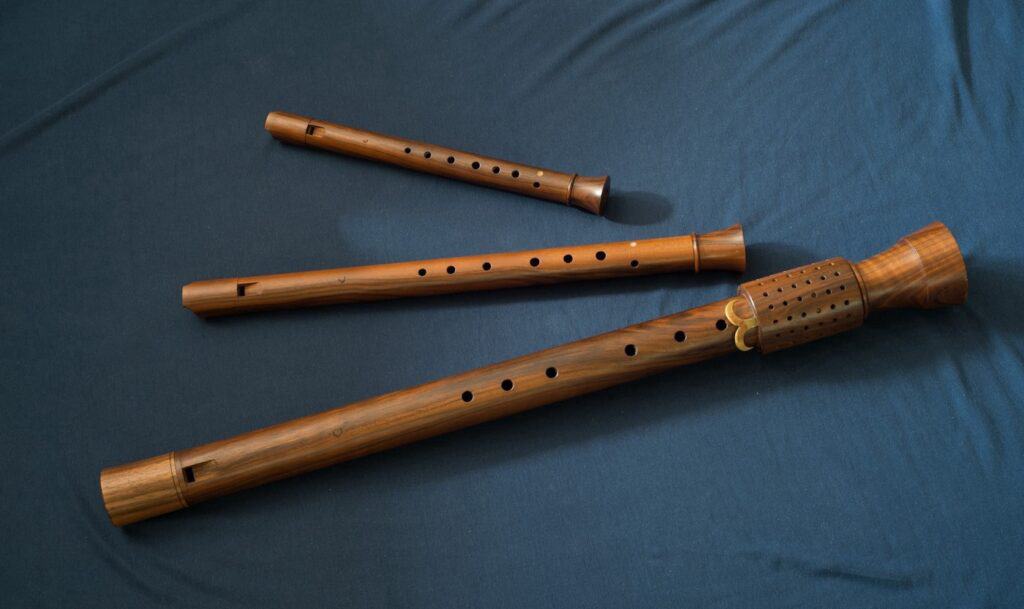
The recorder is a small, flute-like musical instrument that is often used in elementary school music classes. It is a relatively easy instrument to learn to play, which makes it a popular choice for young children. The recorder has a simple design, with just six holes in the front and one in the back.
The player blows into the mouthpiece and uses their fingers to cover and uncover the holes to create different notes.
Recorders come in different sizes, with soprano recorders being the most common. Soprano recorders have a range of about two octaves and are tuned to C major. There are also alto and tenor recorders, which are larger than soprano recorders and have a lower pitch. Bass recorders are the largest type of recorder and have a range of about three octaves.
The recorder has a long history, with the first recorded instances of the instrument dating back to the 14th century. It was particularly popular during the Renaissance period when it was used as both a solo and ensemble instrument. The recorder fell out of favor in the 18th century but experienced a revival in the 20th century. Today, it is widely used in schools and amateur music groups.
If you’re interested in learning to play the recorder, there are a few things you’ll need to get started. In addition to the instrument itself, you’ll need a music stand, a tuner, and a metronome. You may also want to purchase a beginner’s method book or take lessons from a qualified instructor. With a little practice, you’ll be playing your favorite tunes in no time!
4. Glockenspiel
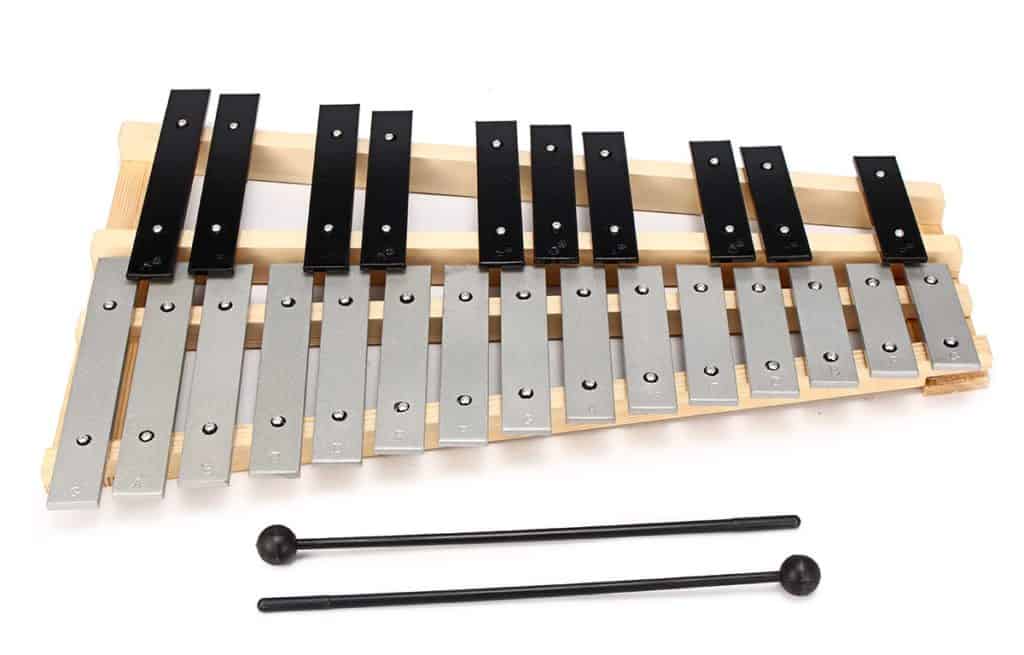
The glockenspiel is a small percussion instrument that consists of a set of tuned metal plates or bars suspended in a frame. Each plate produces a distinct pitch when struck with a mallet, and the player creates melodies by striking the plates in sequence.
Glockenspiels are often used in music education to teach basic melodic concepts, and they are also popular instruments for beginning musicians. Many modern glockenspiels also include features such as volume control and built-in rhythms, making them even more versatile.
Expert Tip: If you’re interested in learning how to play the glockenspiel, there are plenty of resources available online and in print. You can also find glockenspiels for sale at most musical instrument stores.
5. Triangle
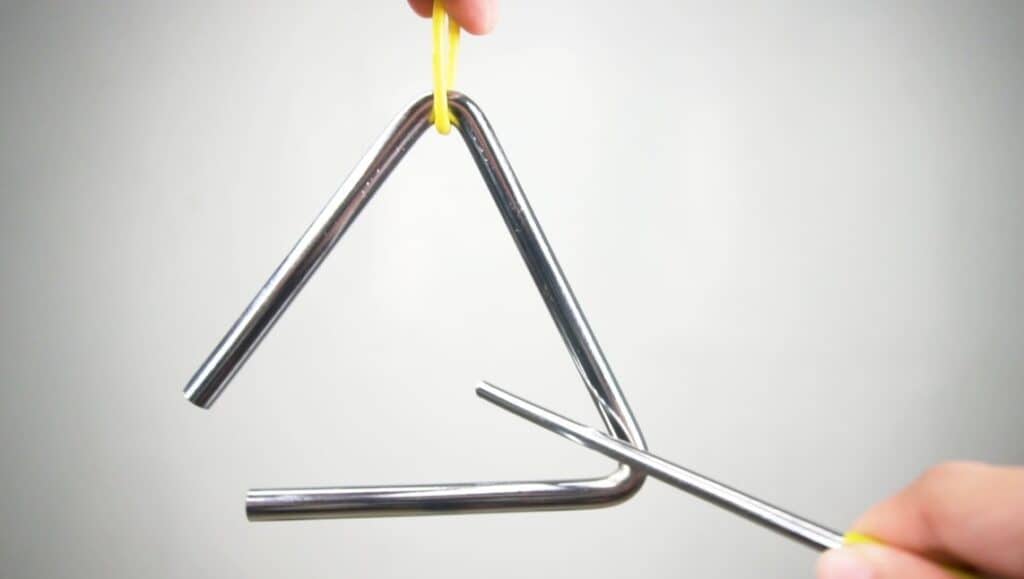
A triangle is a three-sided musical instrument that is played by striking the sides with a beater. It is a percussion instrument and produces a bright, ringing sound. The triangle is often used in orchestral music and can be heard in many famous pieces, such as The Nutcracker Suite and The Ride of the Valkyries.
The triangle has a long history and was used by ancient cultures all over the world. In Europe, it was known as early as the 12th century and was used extensively in medieval music. The triangle became more widely known in the Renaissance period when it was used by composers such as Giovanni Gabrieli and Claudio Monteverdi.
The triangle is a relatively simple instrument and is easy to learn how to play. It is often used in elementary school music programs as it is a fun and easy way for young children to make music.
If you are interested in learning how to play the triangle, there are many resources available online and in libraries. You can also purchase a triangle at most music stores. With a little practice, you will be able to add this fun and versatile instrument to your musical repertoire!
The triangle became more widely known in the Renaissance period when it was used by a composer such as Giovanni Gabrieli and Claudio Monteverdi.
Today, the triangle is still a popular choice for elementary school music programs, as it is a fun and easy way for young children to make music. If you are interested in learning how to play the triangle, there are many resources available online or in your local library.
You can also purchase a triangle at most music stores. With a little practice, you will be able to add this fun and versatile instrument to your musical repertoire!
6. Cymbals

Cymbals are small instruments that can be made of different materials, such as bronze, brass, or even titanium. They are used to create sound effects in music and can be played by either striking them together or using a mallet. Cymbals come in many different sizes and shapes and are often used in orchestras, bands, and ensembles.
Cymbals play an important role in creating the overall sound of an orchestra or band. Different types of cymbals can create different sounds, depending on their size, shape, and material. For example, smaller cymbals may produce a higher pitch than larger ones.
Cymbals made of different materials can also create different sounds. For instance, bronze cymbals tend to have a brighter sound than brass cymbals.
Orchestras and bands often use different types of cymbals, depending on the type of music they are playing. For example, symphony orchestras typically use larger cymbals than jazz bands. The size and type of cymbal can also be determined by the musical context in which it is being used.
For instance, soloists often use smaller cymbals than ensembles because they need to be able to hear themselves over the other instruments. Cymbals are generally struck together in order to create sound. However, some players may use a mallet instead of their hands.
Mallets are made of different materials, such as wood or plastic, and can create different sounds depending on the type of cymbal they are used on. For example, striking a brass cymbal with a wooden mallet will produce a softer sound than using a metal one.
7. Tambourine
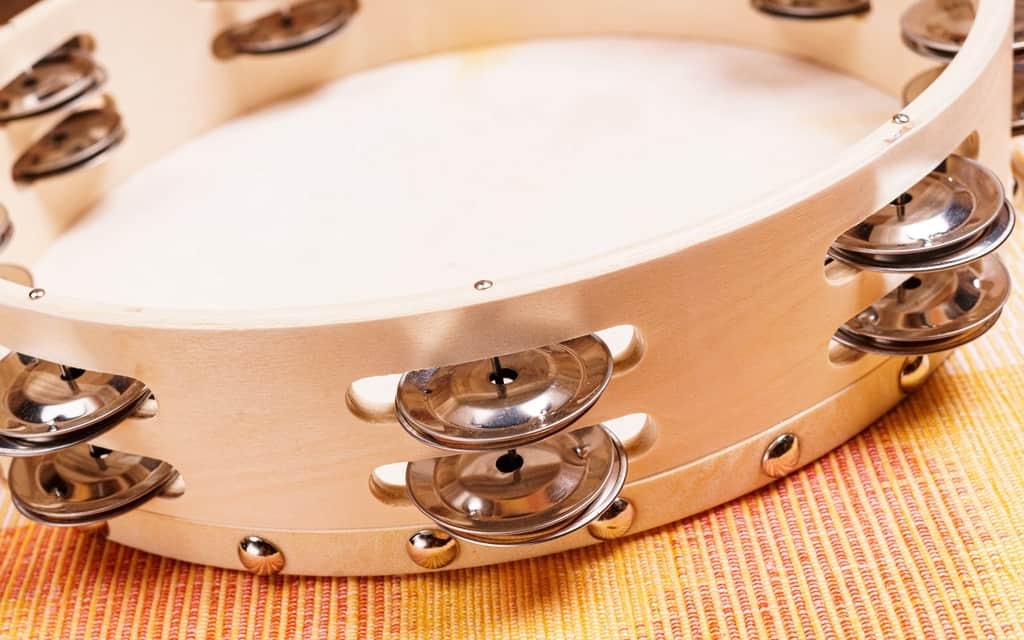
A tambourine is a small, handheld percussion instrument with a cylindrical or flat body and a membrane stretched over one or both ends. It is held in the player’s hand and struck with the fingers, thumbs, or palm to produce a sound.
The tambourine is used in many different musical genres worldwide, including folk music, rock music, pop music, classical music, and jazz.
The tambourine has a long history of being associated with the divine and has been used in religious ceremonies all over the world. In ancient Egypt, the tambourine was often depicted in tomb paintings and reliefs as a symbol of joy and festivity.
In the Bible, the tambourine is mentioned several times, including in the book of Exodus, where it was used by the Israelites as they marched around the walls of Jericho. In medieval Europe, the tambourine was sometimes called a “drum of paradise” due to its association with heaven and the angelic realm.
The tambourine is also known for its use in therapy and healing. It is said to promote relaxation and help to ease anxiety and stress. The vibrations of the tambourine are thought to have a positive effect on the body and mind, providing a sense of well-being and calm.
8. Maracas
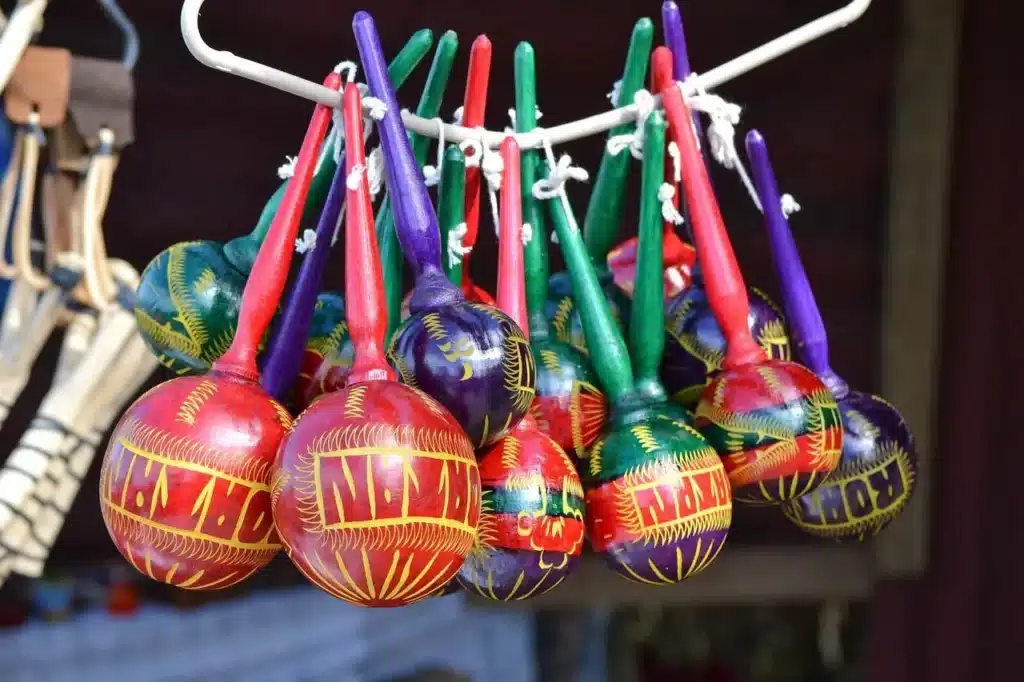
Maracas are small percussion instruments that consist of a pair of dried gourds filled with small pebbles or seeds. They’re held in the player’s hand and shaken to produce a rattling sound. Maracas are commonly used in Latin American music to add rhythm and spice.
9. Castanets
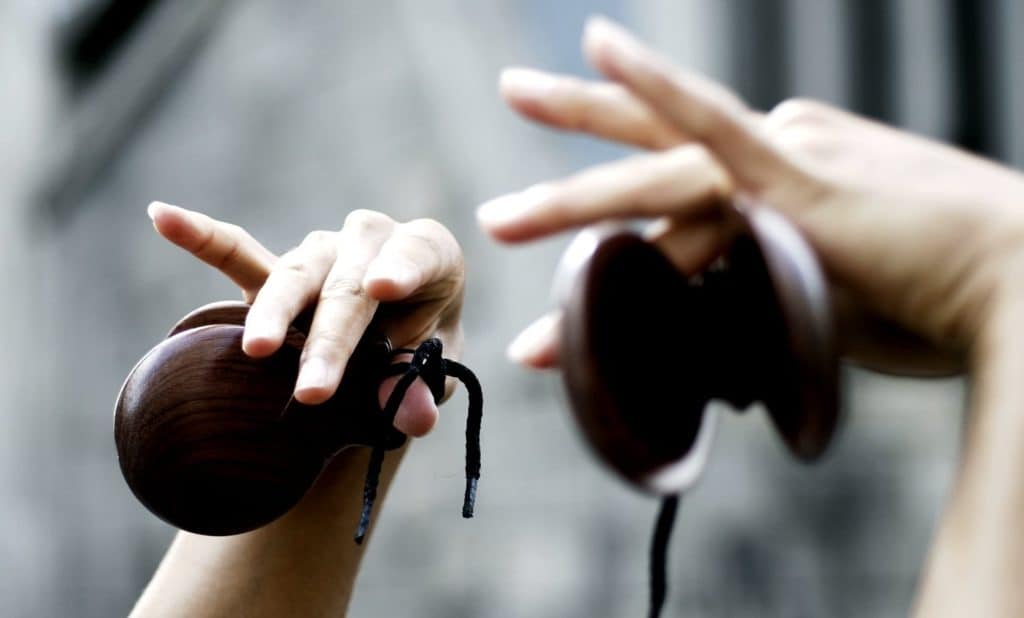
Castanets are small percussion instruments that consist of a pair of hardwood plates connected by a hinge. They’re held in the player’s hand and clicked together to produce a sharp, clicking sound. Castanets are commonly used in Spanish music to add rhythm and flair.
10. Bongos
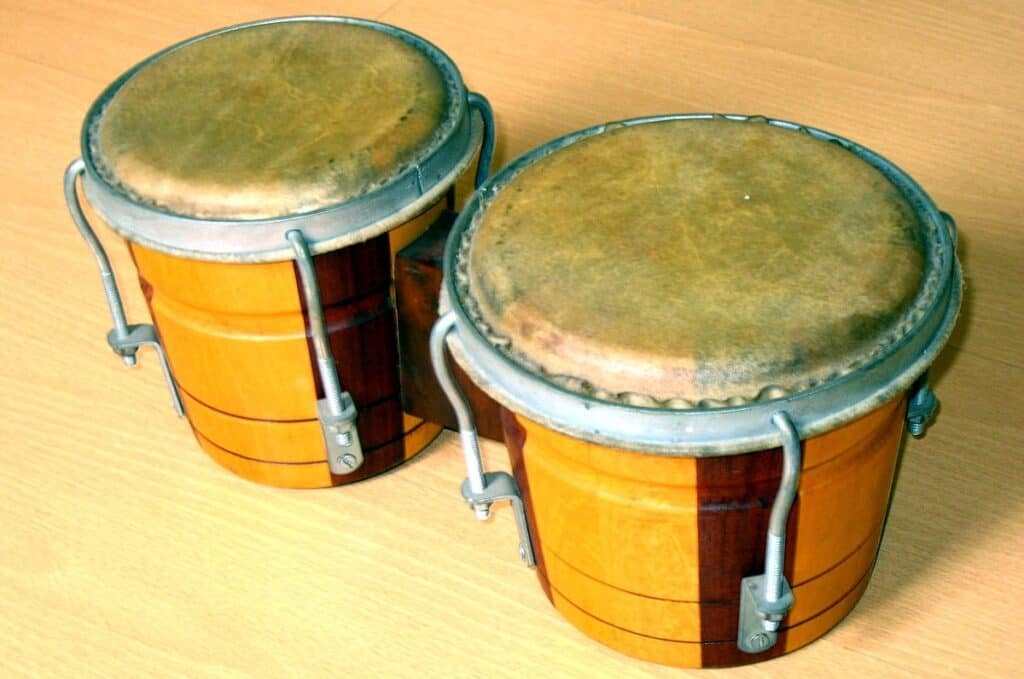
Bongos are small percussion instruments that consist of a pair of drums mounted on a stand. They’re played by striking the drums with their hands. Bongos are very popular in Latin American music and have a very distinctive sound.
11. Congas
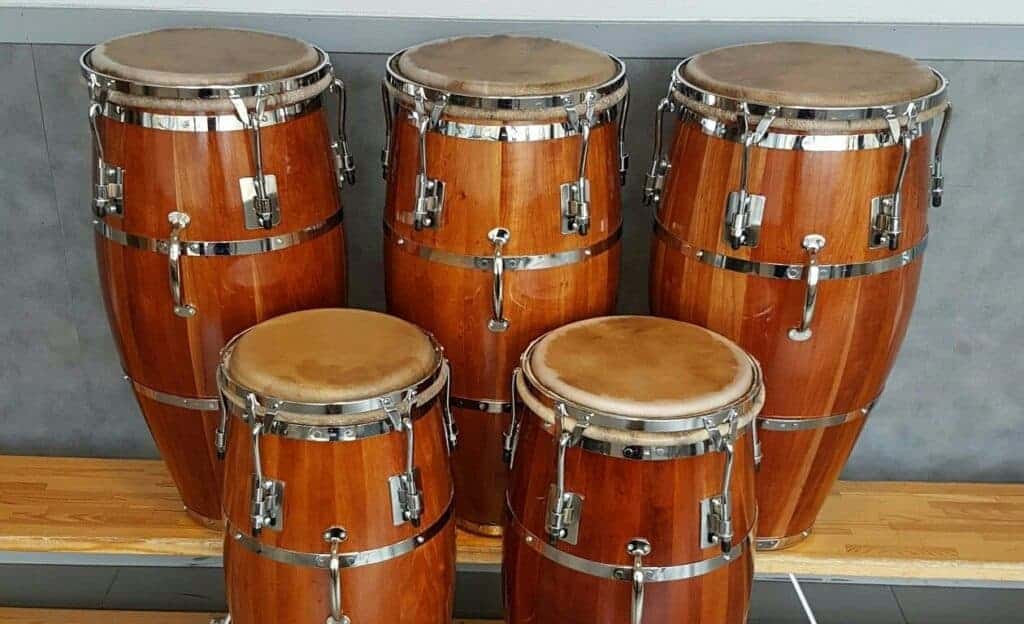
Congas are large, single-headed drums that originate from Cuba. They’re played with the hands and have a very deep, resonant sound. Congas are often used in Latin American music to provide the rhythmic foundation for the rest of the band.
12. Djembe
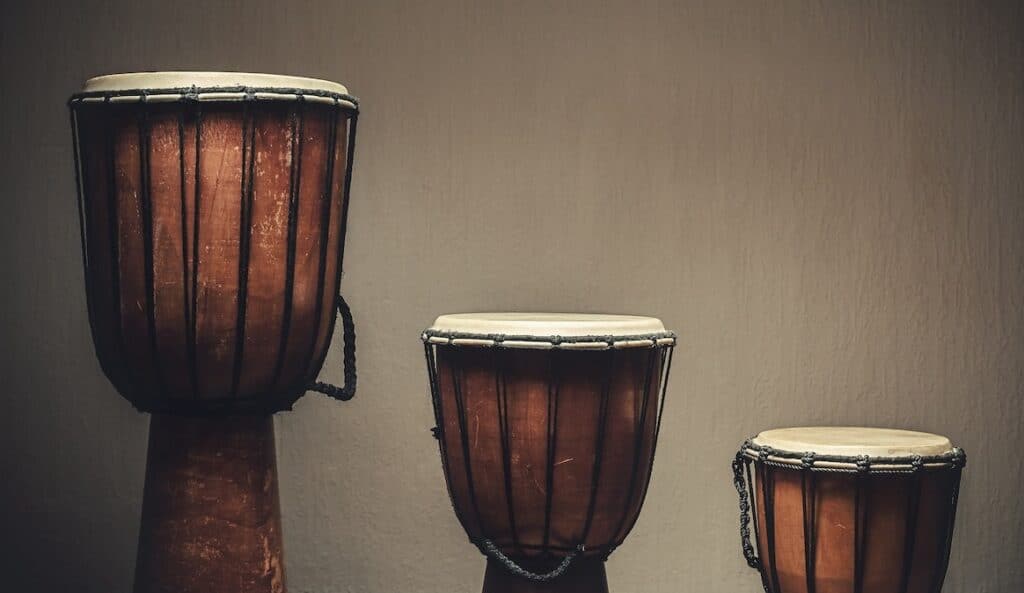
Djembe is a small instrument. It is made of wood and has a skin on top. The skin is usually goatskin. Djembe is played with the hands. The player sits on the ground and holds the djembe between his legs. He uses his right hand to hit the skin and his left hand to hold the bottom of the djembe.
Expert Tip: Djembe can be played alone or with other instruments. When played with other instruments, it usually leads to a rhythm.
Djembe is a very popular instrument in Africa. It is used in many different types of music, including traditional African music, pop music, and even rock music. Djembe is also becoming popular in other parts of the world: such as Europe and the United States.
13. Cajon
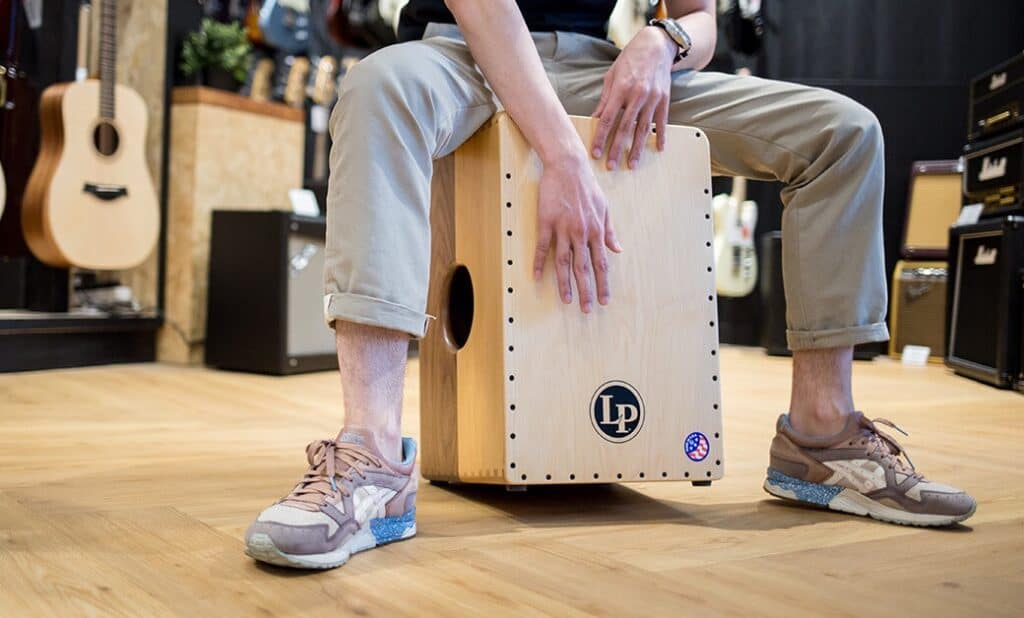
The Cajon is a small percussion instrument that originates from Peru. It consists of a wooden box that is played with the hands. The Cajon is very versatile and can be used for a variety of genres, from Latin American music to rock and pop.
14. Cowbell
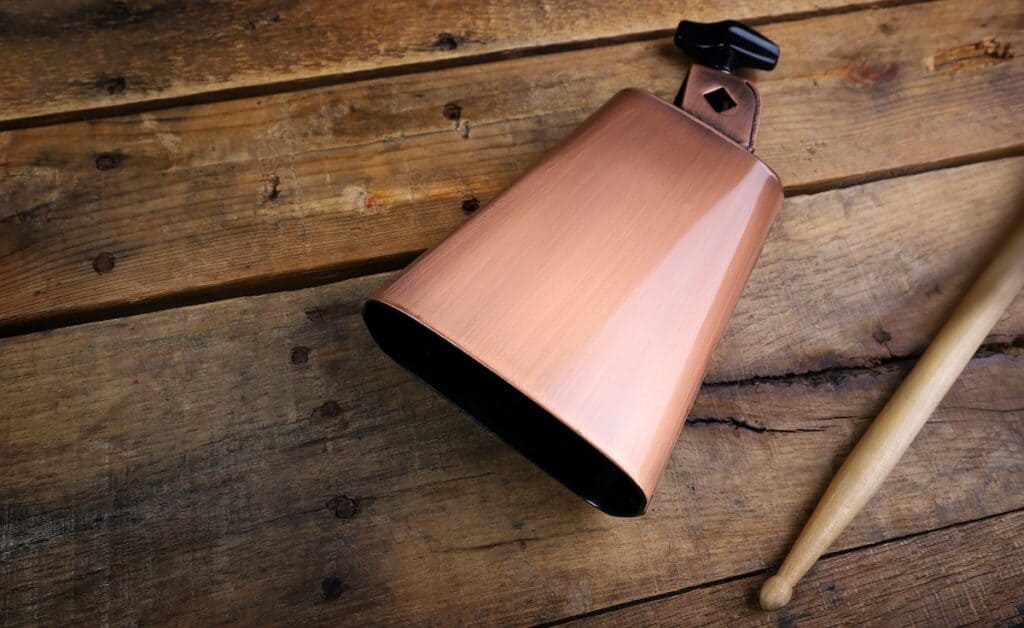
The cowbell is a small, handheld percussion instrument that is played by striking it with a mallet or other object. It is traditionally used in folk music and dance, as well as in certain types of popular and rock music. Cowbells can be made from a variety of materials, including metal, wood, glass, or plastic. They vary in size, shape, and pitch, depending on their intended use.
Cowbells are often used to keep rhythm during dances or songs, and they may also be used to signal changes in the music or tempo. In some cases, multiple cowbells may be played simultaneously to create a more complex sound. Cowbells can also be used for solo performances or as part of a larger percussion ensemble.
While cowbells are often associated with Switzerland and Alpine folk music, they have also been used in a variety of other musical traditions around the world. In recent years, the cowbell has gained popularity as a solo instrument, thanks to its use by musicians such as Beastie Boys member Adam Horovitz and Red Hot Chili Peppers drummer Chad Smith.
15. Woodblock

Woodblock is one of the oldest and most popular musical instruments in the world. It is made from a piece of wood, usually hardwood, and has a small hole in the middle. The player uses a thin stick to hit the side of the block, which makes a sharp, high-pitched sound.
Woodblock instruments are used in many different types of music, including folk, traditional Chinese, and Japanese music, as well as in modern pop and rock. They are often used to add rhythm or percussion to a piece of music and can be played solo or in groups.
Despite its simple design, the woodblock is a versatile instrument that can produce a wide range of sounds. With practice, players can create complex rhythms and patterns. The woodblock can also be used to create sound effects, such as the sound of a horse galloping or a train passing by.
What are the 5 Main Types of Instruments?
There are five main types of instruments: strings, woodwinds, brass, keyboards, and percussion. Each family has its own unique sound, and each instrument within a family can produce a wide range of tones.
String instruments are played by strumming or plucking the strings with a finger, bow, or plectrum. The sound is created by the vibration of the strings, each of which is a very specific width and tuned to a precise tightness to make the right note. The most common string instruments are the guitar, bass, violin, and cello.
Woodwind instruments are played by blowing air into a mouthpiece to create sound. The most common woodwind instruments are the flute, clarinet, and saxophone. Woodwind instruments may have a reed, which vibrates to create sound, or they may use a whistle-like mouthpiece.
Brass instruments are also played by blowing air into a mouthpiece, but the player’s lips must buzz inside the mouthpiece to create sound. The most common brass instruments are the French horn, trombone, tuba, and trumpet.
Keyboard instruments are played by pressing keys on a keyboard to create sound. The most common keyboard instruments are the piano and organ. Each key on a keyboard instrument produces a different note, and the player can create a wide range of sounds by playing different combinations of notes.
Percussion instruments are played by hitting or shaking them to create sound. The most common percussion instruments are the drums, cymbals, and xylophones. Percussion instruments can be made from a wide range of materials, including wood, metal, and even glass.
What Instrument is Smaller than a Guitar?
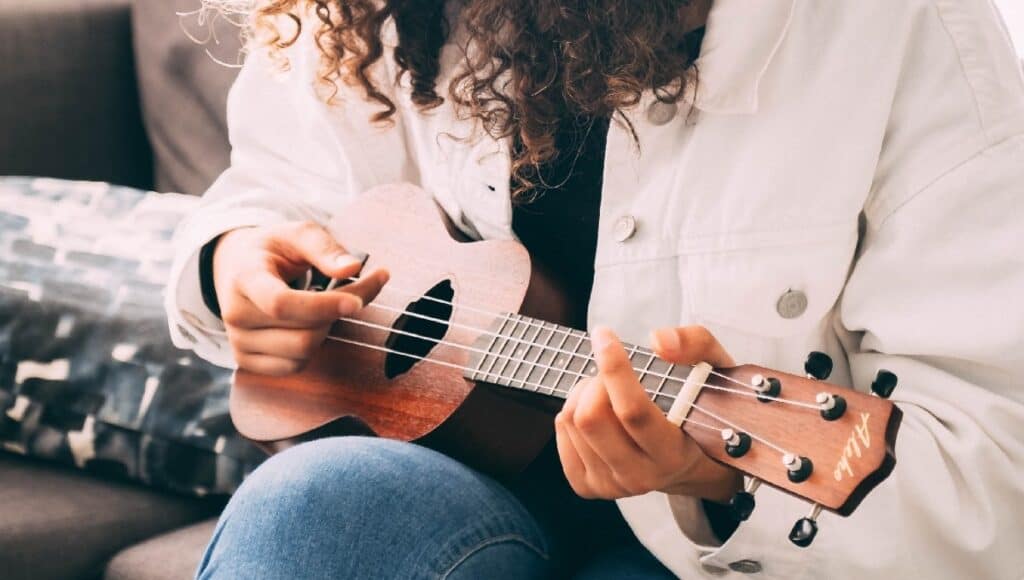
There are many instruments smaller than a guitar, even within the string family. The ukulele, for example, is a popular choice for those looking for a smaller, more portable option than a guitar. Other instruments in the string family include the violin and cello, which are both much smaller than a guitar.
There are also many wind instruments that are smaller than a guitar, such as a flute, clarinet, or even the trumpet. These instruments are often lighter and more portable than a guitar, making them ideal for travel or taking to gigs.
There are even percussion instruments that are smaller than a guitar. The tambourine, for example, is a popular choice for those looking for a smaller instrument to play.
In general, any instrument that is smaller than a guitar is considered to be a “small instrument.” This includes both string and wind instruments. There are many different types of small instruments, so it really depends on the person’s preference as to which one they choose.
What is the Smallest Instrument in the String Family?
Violins are the smallest instrument in the string family. Specifically the 1/16 violin. It measures 14 inches from one end to the other and is often used by young children. It has a shorter neck and a smaller body than a full-size violin, making it easier to hold and play.
The 1/16 violin is tuned the same as a regular violin, but the strings are a bit higher in pitch. This makes the 1/16 violin a good choice for those who want to learn to play the violin but have small hands or are short in stature.
Violins come in seven different sizes, ranging from 14 inches to 22 inches. By these measurements, the next smallest string instrument would be the Soprano ukelele. It is the smallest of the five ukelele sizes, measuring 21 inches. The strings on a Soprano ukelele are also higher in pitch than those on a regular violin.
In conclusion, these small instruments make a huge sound! They are perfect for kids or adults who want to get into music. They are also great for experienced musicians who want to add more depth and richness to their sound.
So whether you’re a beginner or a seasoned pro, be sure to check out some of these small instruments the next time you’re looking to add a new dimension to your music.
